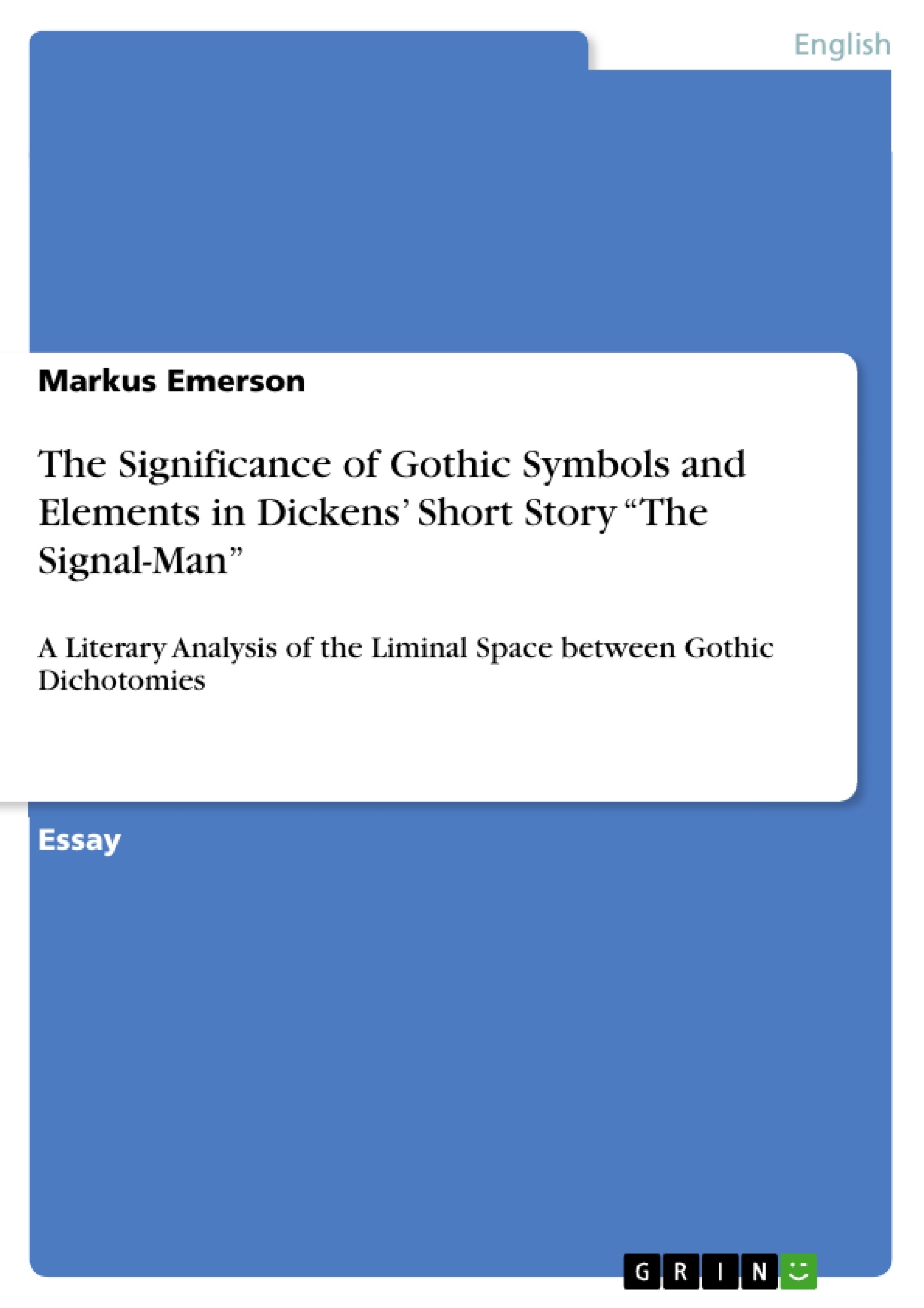Charles Dickens’ short story “The Signal-Man”, published in 1866, is deeply connected with the spirit of the nineteenth century Britain. The huge impact of new technologies and economic development, together with Darwin’s new theories about evolution challenged not only religious people. While many British people were looking towards a future of technology, empowered by new inventions in the time of the industrial revolution, many others found themselves struggling with the new ways of life. It is not surprising that in this period, when the people, according to Wilson, experienced “the most radical transformation ever seen by the world”, many could not cope with the changes (Wilson I).
Parts of the population, which were struggling with this change, were looking back in time to oppose this new situation. This led to a revival of Gothic values and ideas as an opposing force towards new developments. Dichotomies between science and belief, between mind and body were distinctive for Britain in the Victorian era. Nevertheless, the majority of the people found themselves somewhere between the two extremes. This space of in-between, the author will refer to as a ‘liminal space’, where Gothic elements are present and doubts govern the people. The narrator of Dickens’ Gothic short story finds himself drawn in this liminal space between the two prevailing extremes like many other people around that time.
The following essay will look at this liminal space and discuss the significance of the Gothic elements in Dickens’ “The Signal-Man”. The focus of discussion will be on an excerpt of the story, where Dickens’ narrator tries to convince the Signal-Man that what he believes to be a ghost is in fact only a deception of his senses. In the course of this excerpt the reader can see how the narrator gets more and more unsure about the incidents and is therefore motioning towards the liminal space between science and supernatural beliefs.
Inhaltsverzeichnis (Table of Contents)
- Charles Dickens' “The Signal-Man” and the Liminal Space
- Setting and Narrativity
- The Railway and the Industrial Revolution
- The Ghost and the Supernatural
- The Gothic Elements in “The Signal-Man”
Zielsetzung und Themenschwerpunkte (Objectives and Key Themes)
This essay explores the significance of Gothic elements in Charles Dickens' short story “The Signal-Man”, focusing on the excerpt where the narrator attempts to convince the Signal-Man that his ghostly visions are merely a deception of his senses. The essay analyzes the liminal space created by the story's setting and narrativity, examining how it reflects the anxieties and uncertainties of Victorian society amidst the rapid technological advancements of the industrial revolution.
- The liminal space between science and belief in the supernatural
- The impact of new technologies and industrial revolution on society
- The Gothic elements of darkness, the uncanny, and the supernatural
- The contrast between rationalism and superstition
- The ambiguity surrounding the existence of ghosts
Zusammenfassung der Kapitel (Chapter Summaries)
The first section of the essay introduces the context of Dickens' “The Signal-Man” within the Victorian era, highlighting the social and cultural transformations brought about by the industrial revolution and Darwin's theories of evolution. It establishes the liminal space as a central theme, representing the tension between scientific advancements and traditional beliefs. The second section delves into the setting of the story, emphasizing the contrasting worlds of the narrator and the Signal-Man. The “unnatural valley” where the Signal-Man works symbolizes the unknown and the Gothic elements that pervade the story. The railway, as a symbol of technological progress, is also examined in relation to the anxieties and fears associated with the industrial revolution. The third section focuses on the presence of the ghost in the story, discussing its significance as a symbol of the liminal space between life and death and its role in enhancing the Gothic atmosphere. The fourth section analyzes the narrativity of the story, highlighting the contrast between the narrator's rational approach and the Signal-Man's superstitious beliefs. The narrator's attempts to explain the Signal-Man's visions through scientific reasoning create an atmosphere of ambiguity and uncertainty. The final section concludes by emphasizing the importance of the liminal space in Dickens' “The Signal-Man” and its reflection of the cultural anxieties and debates surrounding science and spirituality in the nineteenth century.
Schlüsselwörter (Keywords)
The key themes and concepts explored in this essay include the liminal space, Gothic elements, industrial revolution, technology, science, belief, the supernatural, the uncanny, and the ambiguity surrounding the existence of ghosts.
- Arbeit zitieren
- Markus Emerson (Autor:in), 2011, The Significance of Gothic Symbols and Elements in Dickens’ Short Story “The Signal-Man”, München, GRIN Verlag, https://www.grin.com/document/311085
-

-

-

-
Laden Sie Ihre eigenen Arbeiten hoch! Geld verdienen und iPhone X gewinnen. -

-
Laden Sie Ihre eigenen Arbeiten hoch! Geld verdienen und iPhone X gewinnen. -

-
Laden Sie Ihre eigenen Arbeiten hoch! Geld verdienen und iPhone X gewinnen. -

-
Laden Sie Ihre eigenen Arbeiten hoch! Geld verdienen und iPhone X gewinnen. -

-
Laden Sie Ihre eigenen Arbeiten hoch! Geld verdienen und iPhone X gewinnen.

